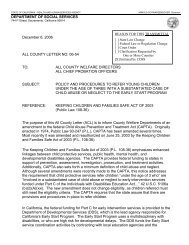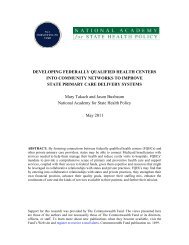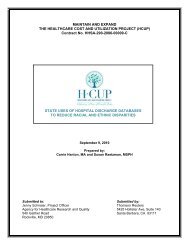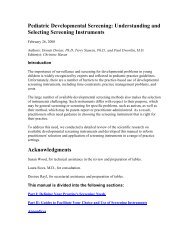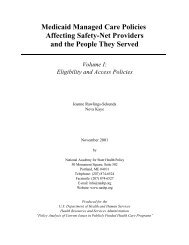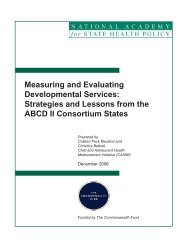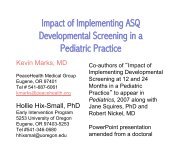Improving Care Coordination, Case Management, and Linkages to
Improving Care Coordination, Case Management, and Linkages to
Improving Care Coordination, Case Management, and Linkages to
You also want an ePaper? Increase the reach of your titles
YUMPU automatically turns print PDFs into web optimized ePapers that Google loves.
18<br />
require that infants <strong>and</strong> <strong>to</strong>ddlers who have experienced substantiated child maltreatment be referred <strong>to</strong><br />
Part C. Due <strong>to</strong> slow implementation, the full impact of these provisions has yet <strong>to</strong> be realized. However,<br />
using data from the National Survey of Child <strong>and</strong> Adolescent Well-Being, a recent study estimated that<br />
while 55 percent of infants <strong>and</strong> <strong>to</strong>ddlers with substantiated cases of maltreatment are subject <strong>to</strong> at least<br />
five risk fac<strong>to</strong>rs associated with adverse developmental outcomes, only 3 percent were reported <strong>to</strong> have a<br />
diagnosed medical condition (an established risk condition) that would make them au<strong>to</strong>matically eligible<br />
for Part C services. 45<br />
The IDEA Part B Preschool Special Education program provides grants <strong>to</strong> states <strong>to</strong> make special education<br />
<strong>and</strong> related services available for children aged three through five with disabilities. Unlike the Part C<br />
program, the preschool program uses definitions comparable <strong>to</strong> those used for older children <strong>and</strong> youth<br />
through age 21. As a result, eligibility <strong>and</strong> family support services (often including CC/CM) are more<br />
limited.<br />
States also have the option <strong>to</strong> combine Part C <strong>and</strong> Part B preschool programs <strong>to</strong> create a continuum of<br />
services <strong>and</strong> early interventions <strong>to</strong> all children ages birth <strong>to</strong> 5. In theory, this would allow for an improved<br />
continuum of family-centered services. In practice though, no state has combined these programs, frequently<br />
citing concerns about levels of funding.<br />
While states choosing <strong>to</strong> participate in the Part C program agree <strong>to</strong> assure an entitlement for eligible<br />
infants <strong>and</strong> <strong>to</strong>ddlers, the federal funding is not an open-ended entitlement but rather a set allocation.<br />
Allocations of grant funding <strong>to</strong> each state are based on census figures of the number of children, birth<br />
through 2, in the general population. As with Part B programs, state <strong>and</strong> local health <strong>and</strong> education agencies<br />
provide a majority of program funding. In addition, some states bill or require that families <strong>and</strong> private<br />
health plans contribute <strong>to</strong> Part C financing. 46<br />
<strong>Improving</strong> <strong>Care</strong> <strong>Coordination</strong>, <strong>Case</strong> <strong>Management</strong>, <strong>and</strong> <strong>Linkages</strong> <strong>to</strong> Service for Young Children: Opportunities for States<br />
National Academy for State Health Policy



